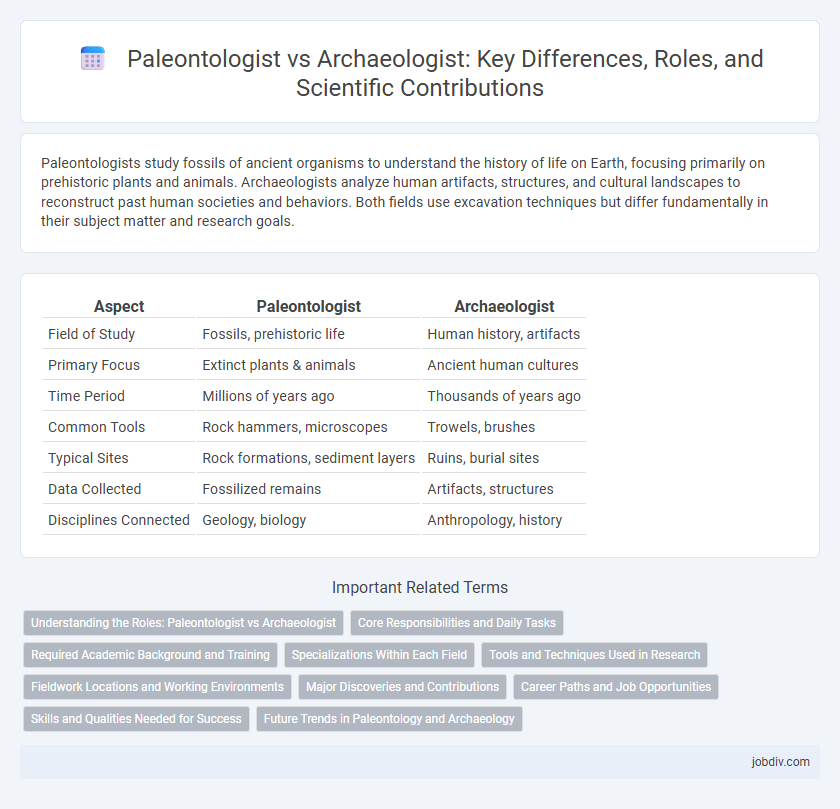Paleontologists study fossils of ancient organisms to understand the history of life on Earth, focusing primarily on prehistoric plants and animals. Archaeologists analyze human artifacts, structures, and cultural landscapes to reconstruct past human societies and behaviors. Both fields use excavation techniques but differ fundamentally in their subject matter and research goals.
Table of Comparison
| Aspect | Paleontologist | Archaeologist |
|---|---|---|
| Field of Study | Fossils, prehistoric life | Human history, artifacts |
| Primary Focus | Extinct plants & animals | Ancient human cultures |
| Time Period | Millions of years ago | Thousands of years ago |
| Common Tools | Rock hammers, microscopes | Trowels, brushes |
| Typical Sites | Rock formations, sediment layers | Ruins, burial sites |
| Data Collected | Fossilized remains | Artifacts, structures |
| Disciplines Connected | Geology, biology | Anthropology, history |
Understanding the Roles: Paleontologist vs Archaeologist
Paleontologists specialize in studying fossils to understand prehistoric life, focusing on ancient plants, animals, and microorganisms that existed millions of years ago. Archaeologists investigate human history and prehistory through artifacts, structures, and cultural remains, emphasizing human activity and societal development. Both disciplines contribute valuable insights into Earth's past, but paleontology centers on biological evolution while archaeology centers on human culture.
Core Responsibilities and Daily Tasks
Paleontologists specialize in studying fossils and ancient life forms to understand evolutionary history, analyzing sedimentary rock layers and fossilized remains through fieldwork and laboratory research. Archaeologists focus on uncovering and interpreting human artifacts, structures, and cultural landscapes, conducting excavations and analyzing materials to reconstruct past human activities. Both professions involve meticulous data recording, but paleontologists emphasize biological evolution while archaeologists prioritize human history and cultural development.
Required Academic Background and Training
Paleontologists typically hold degrees in geology, biology, or paleontology, often requiring advanced studies such as a master's or Ph.D. focused on fossil analysis and evolutionary biology. Archaeologists generally pursue degrees in anthropology or archaeology, with training emphasizing excavation techniques, human history, and cultural analysis. Both fields require hands-on experience in fieldwork, laboratory analysis, and specialized methods relevant to their distinct research subjects.
Specializations Within Each Field
Paleontologists specialize in studying prehistoric life through fossils, focusing on extinct organisms such as dinosaurs, ancient plants, and marine creatures, often analyzing sedimentary rock layers to understand evolutionary history. Archaeologists concentrate on human history and prehistory by excavating artifacts, structures, and cultural remains, with subfields including bioarchaeology, maritime archaeology, and ethnoarchaeology to explore diverse aspects of past human societies. Both fields utilize specialized techniques and technologies, such as radiometric dating in paleontology and stratigraphy in archaeology, to reconstruct historical timelines and environmental contexts.
Tools and Techniques Used in Research
Paleontologists rely heavily on tools such as rock hammers, chisels, and brushes to excavate and analyze fossilized remains, alongside advanced imaging technologies like CT scans for detailed internal examinations. Archaeologists utilize trowels, sieves, and ground-penetrating radar (GPR) to uncover and study artifacts within human settlements, employing stratigraphic analysis to interpret site formation processes. Both fields incorporate GIS mapping and radiometric dating methods to reconstruct historical and prehistorical environments accurately.
Fieldwork Locations and Working Environments
Paleontologists primarily conduct fieldwork in remote sedimentary rock formations, ancient fossil beds, and prehistoric sites where they excavate remains of extinct organisms. Archaeologists work extensively at historical and cultural sites, including ancient settlements, burial grounds, and urban ruins, often within more accessible environments. Both specialists adapt to outdoor conditions, but paleontologists frequently face rugged terrain and harsher climates compared to archaeologists' typically varied archaeological dig sites.
Major Discoveries and Contributions
Paleontologists have made major discoveries such as the identification of dinosaur fossils like Tyrannosaurus rex and the reconstruction of ancient ecosystems, providing crucial insights into Earth's prehistoric life. Archaeologists contribute by uncovering artifacts such as ancient tools, pottery, and human remains from sites like Catalhoyuk and Pompeii, deepening our understanding of early human civilizations and cultural development. Both fields utilize advanced dating techniques and interdisciplinary methods to piece together the history of life and human society on Earth.
Career Paths and Job Opportunities
Paleontologists primarily study fossilized organisms to understand the history of life on Earth, typically working in universities, museums, and geological surveys, with career paths often requiring advanced degrees in paleobiology or geology. Archaeologists focus on human history through excavation and analysis of artifacts, with job opportunities in academic research, cultural resource management, and heritage conservation, usually necessitating a background in anthropology or archaeology. Both professions offer roles in research, education, and preservation, but paleontology leans more towards natural history and geological sciences, while archaeology emphasizes human culture and historical developments.
Skills and Qualities Needed for Success
Paleontologists require strong skills in geology, fossil identification, and evolutionary biology, alongside meticulous attention to detail and patience for excavation and analysis. Archaeologists must excel in cultural anthropology, historical context interpretation, and artifact preservation, with qualities such as critical thinking, communication, and adaptability to diverse field conditions. Both professions demand strong observational skills, analytical reasoning, and proficiency in scientific methodologies to reconstruct past life and human history accurately.
Future Trends in Paleontology and Archaeology
Advancements in technology such as AI-driven data analysis and 3D scanning are revolutionizing both paleontology and archaeology, enabling more precise reconstructions of ancient environments and artifacts. Paleontologists are increasingly using molecular techniques and geochemical analysis to uncover evolutionary patterns, while archaeologists are leveraging remote sensing and drone surveys to locate and interpret previously inaccessible sites. Future trends emphasize interdisciplinary collaboration and digital preservation to deepen understanding of Earth's biological and cultural history.
Paleontologist vs Archaeologist Infographic

 jobdiv.com
jobdiv.com